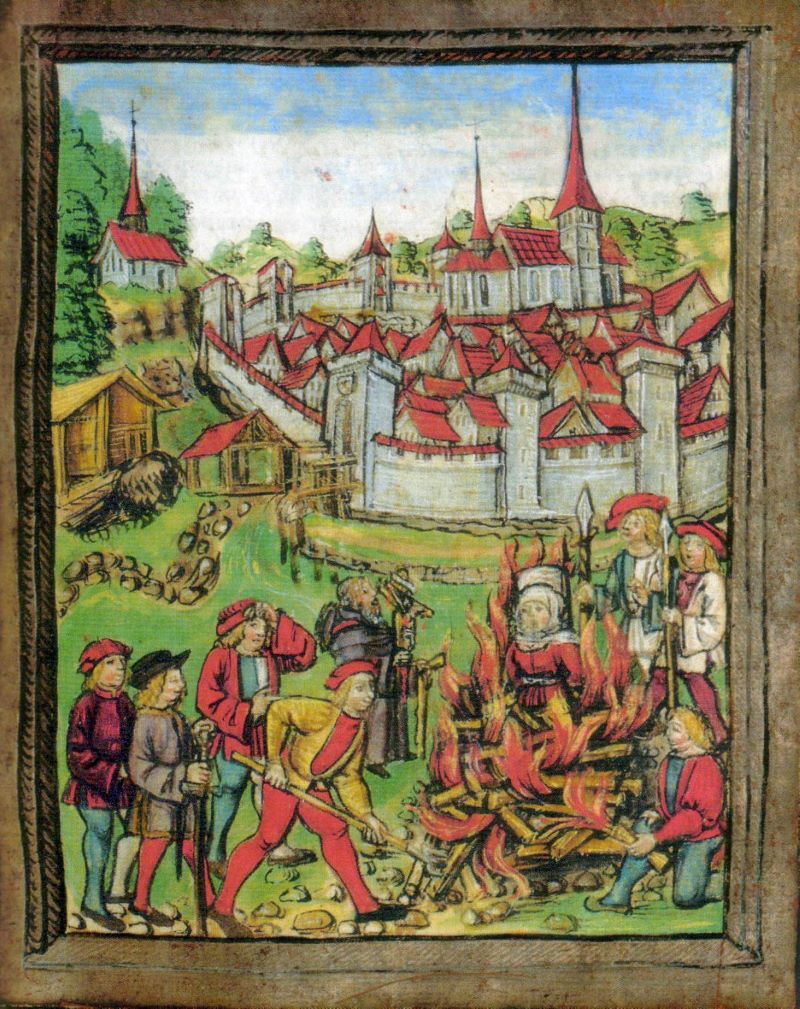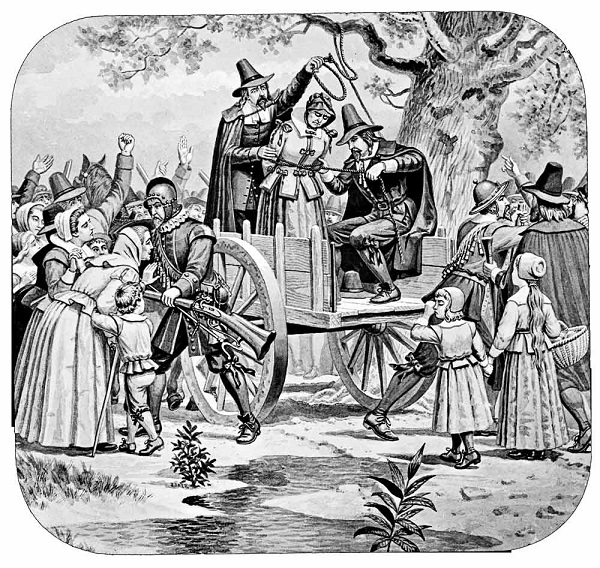It is a common misconception that the people convicted of witchcraft during the Salem Witch Trials were burned at the stake.
The convicted Salem witches were hanged by the neck by a rope tied to a tree. The victims were forced to climb a ladder that was propped up against the tree and then a noose was placed around their neck. The executioner then kicked or pushed the ladder out from under them and they were hanged.
It is believed that the victims were probably hanged from a tree and not gallows because there is no evidence of gallows being erected on the site of the Salem hangings at Proctor’s Ledge and it was customary to hang convicts from trees at the time because the lumber needed to build gallows was so scarce and expensive.
The only exception to the hangings was one accused witch, Giles Corey, who was never convicted because he refused to continue with his trial and, as a result, was tortured to death in a field near the Salem Witch Jail. Corey was slowly pressed to death by placing heavy stones on his chest while he lay on the ground.
Why Were They Not Burned at the Stake?
The reason the Salem Witch Trials victims were not burned at the stake is because English law only allowed death by burning to be used against women who committed high treason.
Men convicted of high treason were dragged, hanged until almost dead and then cut into four pieces, a punishment known as “hanged, drawn and quartered.”
Women weren’t hanged, drawn and quartered in England because it was considered indecent since it involved nudity, according to British Justice of the Court William Blackstone in his book Commentaries on English Law:
“But in treasons of every kind the punishment of women is the same, and different from that of men. For, as the decency due to the sex forbids the exposing and publicly mangling their bodies, their sentence (which is to the full as terrible to sensation as the other) is, to be drawn, to the gallows, and there to be burnt alive” (Blackstone 62.)
Yet, it should be noted that it quickly became common practice in England to always strangle the female prisoner first before being burned (Cobbett 199.) It is not clear if this was done out of mercy or to prevent the prisoner from screaming or crying out during the burning, which happened often.
Another reason witches weren’t burned at the stake in Salem is because witchcraft in England and its colonies was considered a capital crime that was tried in a criminal court while witchcraft cases on the European continent were treated as heresy and were tried in ecclesiastical courts [a court run by the church.] The punishment for heresy was burning at the stake.

Also, both England and the New England colonies were primarily Protestant and burning at the stake was actually more widely practiced in countries that were primarily Catholic.
This is because burning at the stake did not involve the shedding of blood, which was not allowed in the Roman Catholic doctrine, and it ensured that the victim did not have a body to take with them to the after life.
Yet, one documented death by burning did occur in New England in 1681 when a female slave in Massachusetts was accused of burning down two houses in Roxbury, which resulted in the death of a child who lived in the one of the houses, and the slave was burned to death as punishment (Noble 10.)
In England, the hunting and execution of people accused of witchcraft was finally abolished by the Witchcraft Act of 1735 and the burning of women at the stake was finally abolished by the Treason Act of 1790.
Why Were The Salem Witches Executed?
In 1641, the Massachusetts General Court drafted a collection of civil and criminal laws and rights called the Body of Liberties. The Body of Liberties had twelve capital offenses, including witchcraft:
“If any man or woman be a witch, that is, hath or consulteth with a familiar spirit, they shall be put to death. Exod. 22. 188; Deut. 13. 6, 10; Deut. 17. 2, 6.”
Yet, none of the accused witches who actually confessed to the crime were executed during the Salem Witch Trials while 19 people who refused to confess were hanged.

This is most likely due to the Puritan belief that the confessed witches would receive their punishment from God instead.
How Many Witches Were Killed in Salem?
A total of 19 people were hanged for witchcraft in Salem. One person was tortured to death and around four people died in jail while awaiting trial.
In addition, two dogs were also killed when they began behaving strangely and were suspected of either being bewitched or of being witches themselves.
Sources:
Blackstone, William. Commentaries on the Laws of England. Vol. II, J. Grigg, 1827.
Noble, John. The Case of Maria in the Court of Assistants in 1681. John Wilson and Son, 1902.
Cobbet, William and John Wright, Thomas Curson Hansard. The Parliamentary History of England, from the Earliest Period to the Year 1803. Harvard University, 1816.
Simon Devereaux, “The Abolition of the Burning of Women in England Reconsidered.” Crime, Histoire & Sociétés / Crime, History & Societies, Vol. 9, n°2, 2005, 73-98. https://journals.openedition.org/chs/293
Bever, Lindsey and Justin Wm. Mover. “From burning at the stake to lethal injection, how America keeps reinventing capital punishment.” Washington Post, 24 July. 2014, washingtonpost.com/news/morning-mix/wp/2014/07/24/from-burning-at-the-stake-to-lethal-injection-how-america-keeps-reinventing-capital-punishment/
“Witchcraft law up to the Salem witchcraft trials of 1692.” Mass.gov, mass.gov/news/witchcraft-law-up-to-the-salem-witchcraft-trials-of-1692
“Witchcraft: Eight Myths and Misconceptions.” English Heritage, english-heritage.org.uk/learn/histories/eight-witchcraft-myths/
Newman, Caroline. “With UVA’s Help, Salem Finally Discovers Where Its ‘Witches’ Were Executed.” UVA Today, 19 Jan. 2016, news.virginia.edu/content/uvas-help-salem-finally-discovers-where-its-witches-were-executed
Woodside, Christine. “The Site of the Salem Witch Trial Hangings Finally Has a Memorial.” Smithsonian Magazine, 13 July. 2017, smithsonianmag.com/history/site-salem-witch-trial-hangings-finally-has-memorial-180964049/


I grew up on Corey ave in North Kingstown named after my grandfather I found out who Giles and Martha were early in life!! Of course going to school with the last name my grandparents told me my dad and aunts and other family members would be teased because of it!! This will blow your mind,Now on Corey ave there’s a middle street it name was Howard street???? Ironic or did someone in the town know the story??? I put two and two together over a year ago searching out other Corey’s because there’s not many!! I’m not going to say just because of Salem! That would probably unlikely but there aren’t many!! I’m the only Richard Corey in Rhode Island!,Ive found one head stone here in the town I live in,The only other ones are in Exeter RI ware my family plot is or Salem!! But I’ve planned on making another trip to Salem and I am looking to see if the town hall their or surrounding may have some records of them!! But it’s something that shouldn’t have happened and At the age of 79 Giles knew either way them bastards were going to kill him so he did what he did for from a warlock or witch!!